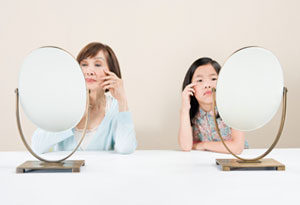You're Older, Wiser, and More Beautiful: The Science Behind Aging Gracefully

Photo: Thinkstock
Mirror, mirror, on the wall, who's the kindest, sparkliest one of all? O talks to psychologists about the kind of beauty age only enhances.
A former boyfriend once told me that he loved the way the skin around my eyes crinkled up when I smiled. "Your crow's-feet," he said admiringly. In my early thirties at the time, I wasn't aware that I had crow's-feet and, frankly, I wasn't too happy about being given the news. But lately I've been rethinking my ex's faux pas. How bad could it have been that this man thought the signs of life on my face were beautiful? Looking back on it, it may have been one of the nicest things he ever said to me.Though it was likely the crow's-feet that my ex admired, research tells us that it is more likely to be symmetry that attracted him to me. Show a group of people a range of human faces, ask them which ones are most attractive, and they'll generally select those with even features—traits that our brains, always on the lookout for good mating material, associate with fertility and good health. Stephen Marquardt, DDS, a maxillofacial-reconstructive surgeon at UCLA Medical Center, now devoting his time to research on notions about beauty, believes that a symmetrical pattern is so integral to attractiveness that he has created a computer-generated template to prove it. When the template, based on mathematical calculations, is superimposed over the visages of acclaimed beauties—Elizabeth Hurley, Marilyn Monroe, even Queen Nefertiti—it fits almost flawlessly.
Still, might we not need more to attract us to another than a mouth 1.618 times the width of a nose (the beauty ideal according to Marquardt)? Other research says yes. "We have found that facial expressions are nearly as important as physical features in determining attractiveness," says Michael Cunningham. PhD, professor of psychology at the University of Louisville in Kentucky. "When people are smiling, others are drawn to them much more than if they look cold." And even Marquardt acknoledges that symmetry can take you only so far. "I've known women more beautiful than my wife, but her face is so alive," he says. "When she smiles, her eyes shine, and it thrills me inside."
Somewhere in the back of our minds, we know that expressiveness is beautiful—it is, after all, one of the first things we pull out of our bag of tricks to attract others. Infants manage the beginnings of a smile within hours of being born, then start grinning in response to other people's smiles at about 4 to 6 weeks. This survival tactic ensures that babies are irresistible to their parents, explains Carroll E. Izard, PhD, Trustees Distinguished Professor of psychology at the University of Delaware. "Their smiles draw any observer to them, too," Izard says.
It's not Audrey Hepburn's wide eyes that make us never tire of watching her in Breakfast at Tiffany's; it's the way she lifts them in wonder and surprise. It's not just Meryl Streep's high cheekbones that rivet us to her face; it's the amusement, intelligence, and vulnerability that play across it. In a recent New York Times article, the literary critic John Bayley confessed to having had a crush on Esther Williams in his youth, not because she was a great swimmer or because of her magnificent figure, but because she had "such a kind face." Which was a quality he professed to love as well in his late wife, author Iris Murdoch.
If you look at a face in repose, says Marquardt, you'll probably be more likely to judge it on architecture. He recently showed an auditorium of 200 people photographs of Julia Roberts and Michelle Pfeiffer and asked them to vote on who's prettier. Only three people raised their hands for Julia. "Michelle Pfeiffer fits the template more closely," says Marquardt. Why, then, are we besotted with Julia? Think of her megawatt smile, her pixieish glance, the sparkle in her expressions.
As much as we appreciate the life in someone else's face, when we think about our own looks, most of us don't take our expressions into consideration. We're probably not even aware of them—how often do you look in the mirror and emote back at yourself? But the power of our expressions is worth considering, espescially in this era of facelifts and Botox injections. One of Izard's studies suggests that we eradicate lines and wrinkles, and the expressions that cause some of them, at our peril. Researchers had mothers smile while playing with their 3-month-old infants, then assume a neutral face. The lack of expression disturbed the babies, who responded with sadness and anger. Adults may respond the same way. "Emotional expression is an essential part of our social communication," says Izard. "Often we're more influenced by what we see than by what we hear from others, so diminishing expression has serious implications for the messages you send."
Since I'm over 40 now and the crow's-feet once admired by my ex have deepened, I like to believe what the actor John Cleese says is true. As host of The Human Face, an insightful documentary about beauty, Cleese expounds on the idea that as you get older your habitual expressions become etched into your face, showing the world what kind of person you are. "If you're beautiful when you get older," he says, "it's not a free gift. It's because your face shows qualities that are timeless—strength, kindness, dedication, wisdom, enthusiasm, and humor, intelligence, compassion."
All the symmetry in the world can't give you that.
Age With Grace, No Matter What



